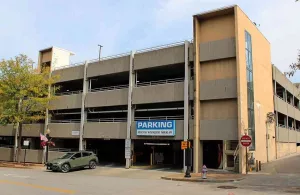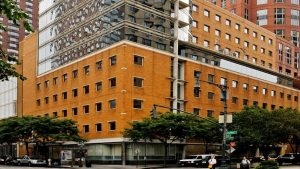Seattle Viaduct demolition reaches dramatic phase just feet from Pioneer Square buildings
Published by John on
Demolition at the Alaskan Way Viaduct is approaching its most suspenseful point, when teams will demolish the four blocks of road decks next to Pioneer Square buildings — some less than 10 feet away.
One team is crunching concrete from the north, the other from the south, converging toward century-old buildings that will be shielded from flying debris by mesh curtains or plywood.
“It’s like hearing demogorgons. You can just hear the pounding and grinding of the machines,” said Pete Kurtz-Glovas, program manager at the Compass Center homeless-services building, likening the growl to a Dungeons and Dragons monster. From the roof Friday, he watched a hammering ram break the top deck as it gradually moved his way
Some clients, seeking the hygiene center, showers and mail service, were confused or even walked away because the main front entrance beneath the viaduct is closed, Kurtz-Glovas said. But most are finding the alternate entry on South Washington Street, he said.
Three blocks south, the glitzy 450 Alaskan office building, built in 2017, is protected by a hanging mesh curtain. On Thursday, white dust drifted onto King Street sidewalks, as arriving commuters scurried indoors. By Friday, the dust subsided when rain fell overnight and the demolition team progressed a half-block north.
Contractors have learned a lot since they began felling the double-decked highway in mid-February. They methodically poke the weak spots in the deck, until spaces between the girders reveal a honeycomb shape. Then, their long-necked crunchers, resembling steel dinosaurs, munch the rebar-laced girders.
For the sensitive August phase, they’ll change tactics, with teams smashing the entire waterfront flank of the lower and upper decks first. At a rate of one pair of decks per day, and 17 deck segments remaining, that should take three to four weeks, said Phil Wallace, senior operations manager for prime contractor Kiewit Pacific.
A more deliberate operation follows, to saw and extract the girders alongside the buildings. A single crane will hold each girder while it’s being sliced, suspended by a pair of chains, Wallace said. At times, two cranes might be needed.
Given the need for caution while coordinating street and walkway detours, demolition subcontractor Ferma will be cutting and clearing those girders until September, said Tom Horkan, project director for the Washington State Department of Transportation (WSDOT).
Once the beams are gone, the roof and top floor of the refurbished C&H Building, a former grain warehouse built in 1900, will open toward sunsets and Elliott Bay. The wood-floored exporting room can then be converted to a cafe, restaurant, or retail, said owner Anne Michelson.
“You’ll never in our lifetimes see anything like it,” said Peter Miller, who owns an architecture bookstore inside the C&H, at 304 Alaskan Way South. “Cleaning up that concrete viaduct, and not getting any of it on the coffee cups, is quite a challenge.”
During the first weeks of viaduct removal, stray shards of concrete cracked two windows in the historic Polson Building at Columbia Street, and the state is handling a claim. The state acknowledges occasional dust complaints, but Horkan said contractors are performing well given the immense amount of material being removed, and shifting winds.
The best they can do, he said, is keep knocking down dust with water hoses and nozzles mounted on the smashing machines.
WSDOT decided to begin viaduct removal at the central waterfront, to clear that section by summer tourist season. That allowed four lanes of surface Alaskan Way to remain open in the south, near the new Highway 99 interchange.
But in July, the south area lost two lanes when demolition arrived there — leading to more traffic jams and stuck buses around First Avenue South..
The demolition schedule is stretching beyond the five- to six-month initial plan. Officials say they don’t expect big cost overruns by contractors, or penalty payments demanded by the state.
On Monday, the state will turn over two cleared blocks of Columbia Street to the Seattle Department of Transportation, where a viaduct onramp used to stand. The city will finish a two-way bus street on the hillside entering downtown that will connect to waterfront bus lanes when surface Alaskan Way is rebuilt in 2020-21.
To the north, concrete removal over BNSF Railway tracks will continue into autumn, below Pike Place Market. Railway regulations limit demolition above rails to six hours a week on Saturdays, Wallace said.
Compass Center resident Arthur Buckner, watching the show from street level Friday morning, said that soon, a fourth-floor men’s gathering hall next to his room will gain waterfront views. He’s also eager for the restored Washington Street Boat Landing Pergola to open, along with a new beach below. The city says the beach will open in 2023, after native plantings and habitat are established.
“They’ve got a little island built up on shore. It’s exciting,” Buckner said.
In a few weeks, plywood planks can be removed from the Compass Center’s four chapel windows that face the bay. The absence of the elevated freeway will invite sunshine into the upper stained-glass windows that depict the Olympic Mountains, Puget Sound and a cross in the foreground.
Unlike other properties where speculation and redevelopment rage, Kurtz-Glovas reassured clients the Compass Center will stay put. The neighboring low-income tenants and at least 300 daily Compass Center visitors can share some of the city’s most striking views.





